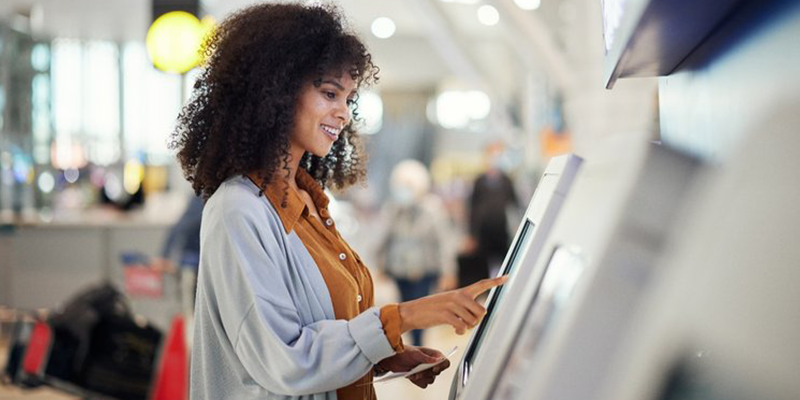
Digital signage, touchscreen, and mobile technology is already prevalent across airports and transportation hubs, and the digital transformation of transportation will only accelerate from here, writes Tyler Wells, ISV and strategic accounts partner manager, Americas, at MicroTouch.
The transportation sector is transforming digitally. The next time you’re in a newly renovated airport, train station, or other transportation hub, look for the evidence. You’ll see new LED departures and arrivals boards updating in real time that travelers can see from any angle. Wayfinding digital signage directs people to the gates they need to catch their flights, trains, or buses and the quickest route to baggage claim and vehicle rentals, helping them save valuable time.
Furthermore, these facilities make even more essential information available to enhance experiences. Travelers can review digital menus outside restaurants or find lists of top-selling books or promotions for items that make their trips more pleasant. Those same digital signs can also provide travelers with urgent messaging, like weather updates, delays, and even breaking news.
The transportation industry is also accommodating the increasing demand for self-service. Travelers can now manage tasks on their own, from boarding passes and baggage tickets to ordering at a café or checking out at a shop. Touchscreen self-service solutions allow them to skip the line, save time, and have greater control over their experiences.
What drives digital transformation in transportation?
Since 2020, every airport or transportation hub renovation has included digital solutions that give travelers easier access to information and self-service options. Several factors are driving technology implementation in transportation:
The critical need for greater efficiency
Transportation hubs have been hit hard by the labor shortage, with vacancies in customer-facing positions in airports, train and bus stations, multimodal centers, and restaurant and maintenance positions. Administrators must make the best use of available labor to keep operations running on schedule. Offering digital wayfinding, information access, and self-service ordering and checkout allows managers to allocate labor to critical tasks rather than continually fielding travelers’ questions and accomplish more with fewer employees.
Revenue-Driving Messaging
Selling advertising space in airports and other transportation hubs is a lucrative enterprise. Companies want to get their messaging in front of thousands of travelers who pass by the signage each day. Furthermore, it’s effective. Ads for the in-demand products at duty-free shops can influence purchases and build revenues for brands and the transportation hub.
Catching Up with Tech Adoption
Transportation hubs must modernize to enable integration with their partners and provide the experiences that consumers demand. While new tech implementation takes time, requiring approvals and budget allocations, it’s still vital for these organizations to move forward to enable efficient data sharing, automate processes, and increase customer satisfaction with their travel experiences.
There’s more technology implementation in transportation’s future
Expect the transportation industry to continue to find ways to leverage technology to improve operations. Artificial intelligence (AI), which is already used for ID verification and security in many airports and transportation hubs, will play a bigger role in the future. For example, digital signage and wayfinding solutions provider 22Miles has developed an AI Assistant with Wayfinding, which allows travelers to ask the system for help in their language of choice, and multilingual digital signage systems provide them with the information they need.
Airports will also find new ways to use AI, for example, analyzing foot traffic patterns to inform plans to minimize bottlenecks or to collect demographic data on people who stop to look at advertisements or products to increase value to advertisers.
Airports and transportation hubs may also increase traveler convenience by taking advantage of personal mobile devices. Apps can allow travelers to scan a QR code to load wayfinding directions onto their smartphones, pay for a purchase, or order food.
Also, look for biometric authentication to become more prevalent, allowing travelers to verify their identities and even make purchases with a fingerprint, facial, or palm vein scan. Transportation hubs are also exploring the use of robots for time-consuming tasks, such as making deliveries across expansive airports or cleaning or enhancing customer experiences by providing information or even escorting travelers to their gates.
The bottom line: now that digital transformation has begun, it will continue and, most likely, accelerate as the returns from greater efficiency, more revenue, and improved experiences will easily justify the investment. Digital signage and touchscreen solutions make travel more convenient and less stressful for consumers, as well as making travel more financially viable for transportation providers — a trend that will only continue to grow.
(January 23, 2024). Tyler Wells – ISV & Strategic Accounts Partner Manager, Americas, MicroTouch. Retrieved from https://www.digitalsignagetoday.com/blogs/why-every-modern-airport-and-transportation-hub-uses-digital-signage-and-touchscreens/
